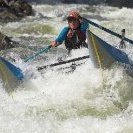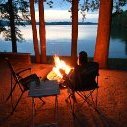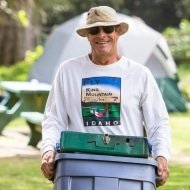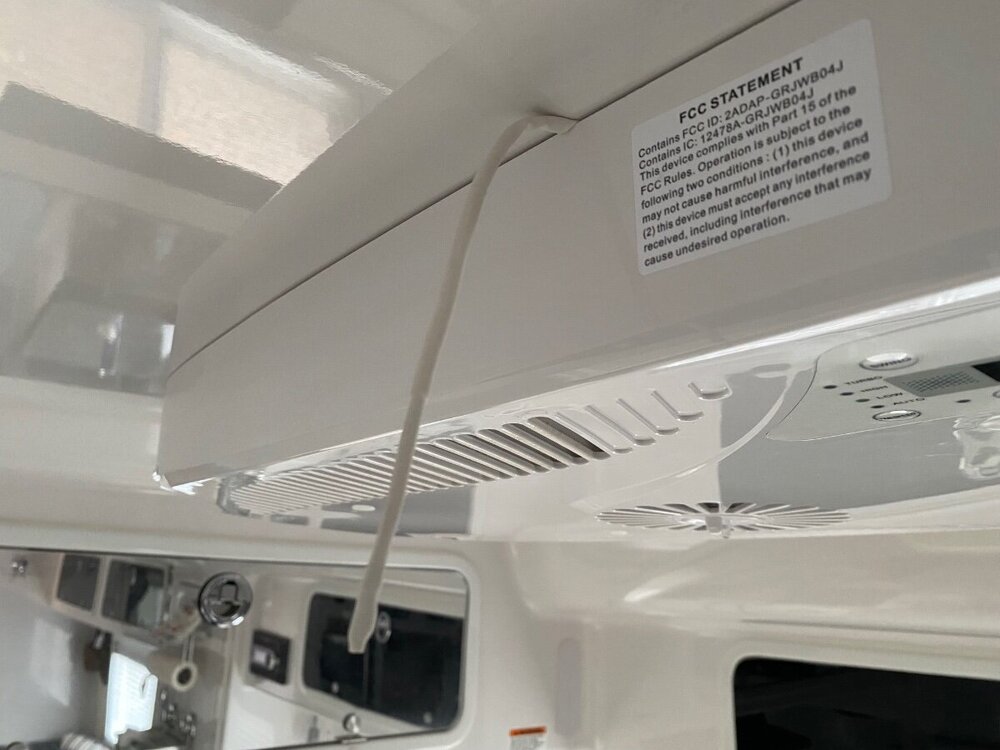All Activity
- Today
-
We're planning a trip to Yosemite soon and I picked up a heated water hose. The forecast is calling for lows just below freezing and it will be a just in case we need to fill our tank. I don't think I'm going to leave it attached, at night, but from what I've read, the heated portion is for that scenario. We'll keep our furnace on at night since it runs quiet, and run our rooftop AC unit heat during the day, so I don't use up all the propane and can save that just for sleeping hours. I also bought a dual voltage plug in Vornado heater, which has a low setting that I plan to run at night since we'll be hooked up to shore power most of our trip. This will be our first trip during colder weather, so I may be over doing it, but wanted to be prepared, just in case it's needed.
-
I'm not familiar with factory solar/lithium systems installed from Oliver and like David, still learning about electrical/electronics. We installed Battleborn Lithium battery with Renogy Solar controller that we use with up to two solar suitcases, and an onboard progressive Lithium charger. We had issues with our MaxxAir fan. It started beeping and a green light on the unit started flashing. Checked internet and found Lithium batteries can cause high voltage issues with MaxxAir fans, when we had the issues we were on shore power, the Progressive lithium charger had our 12V system at 14.4V DC. Also gave MaxxAir/Airxcel technical support a call and they confirmed lithium battery higher voltage can cause the problem we were having with the MaxxAir fan. This had me wondering if the higher lithium voltage would cause issues with other 12V components, checked with Jensen and they said our TV was tested to 16 to 17V without issues. I don't know about other 12V components on Ollie, yet. We installed a DC to DC converter (12.3V output) from Amazon, secured with Velcro. Also replaced the fan's circuit board with one from Amazon, probably unnecessary. It's working OK now. https://www.amazon.com/dp/B081RG8XP5?ref=ppx_yo2ov_dt_b_fed_asin_title&th=1 Found this on YouTube:
-
On our Hull #1291 the sprayer on the outside faucet is threaded onto the supply hose. I screw the sprayer head off the hose, then push the hose through the access hole to the inside of the hull. I then take the sprayer inside, open the driver's side rear hatch, locate the hose and thread the sprayer back onto the hose for cold weather storage.
-
Here are my thoughts: We previously owned an Overland Trailer (which had a Max Air fan). We experienced a voltage issue so I had the Orion-Tr 12/12-9 installed to stabilize and maintain 12v power to the fan. Now I do not have to be concerned about possible spikes or a malfunctioning control board. Max Air Fans operating above 13.8v can damage the fans control board. This will prevent damage to the sensitive control board. The black plastic board material used to secure all components is called Starboard or Black HDPE and I can tell you it’s super tough and used in Marine grade applications. Inverter Services uses lots of this material during their installs. Here - https://www.amazon.com/gp/aw/d/B08M6DJNH4/?_ Open Source info on Max Air Fans- *** MaxxAir fans are designed for a 12 Volt DC system, operating within a voltage range of approximately 10.6–13.6V, with an optimal test voltage of 12.8V. Operating above 13.8V can damage the fan's control board and void the warranty, especially if the system is charging. To prevent issues from voltage spikes, a DC/DC voltage regulator is recommended for stable power, especially when the vehicle's charging system is active.
-
As others have noted, these trailers do very well in cold weather. So I think you'll be fine as long as you have heat. We traveled to Moab for a January wedding. There were several days on the road where the temp never got above freezing and the trailer was covered in ice when we arrived at our overnight stop. We relied mainly on the internal water tank as the supply hose would freeze. One lesson we learned was to be gentle with the trailer when you arrive. Without heat, some of the plumbing may have frozen while traveling. Give it some time with the heat on to thaw out. I broke the toilet petal once by being impatient, not knowing the flush valve in the back had frozen. I carry extra flush valves but the pedal is not available as a separate replacement part. Not my finest hour.
-
@Patriot I have a couple of questions about your Victron/Epoch installation. Do you know what the black material is that they used for mounting the Victron equipment and Andersen connector? I also noticed that you have both an Orion XS 1400 DC/DC charger and an Orion-Tr 12|12 - 9 DC to DC converter. You mentioned that the Orion XS 1400 DC/DC charger was part of the lithium upgrade, so what is the purpose of the Orion-Tr 12|12 - 9 DC to DC converter? Mossey
-
Also, try "pip pins" :)
-
Thanks everyone. I bought 2. One is already functioning as a replacement. The other has been added to the Ollie's garage. 🙂
- Yesterday
-

Winterize requirements
taylor.coyote replied to taylor.coyote's topic in Mechanical & Technical Tips
Thanks for sharing. I would agree many variables will be in play. Rivernerd, how do you pull the outside faucet inside? Your trailer is much newer (about 1,000 trailers after mine), maybe you have different plumbing. I have seen where people layer in additional insulation between the hatch door and the outdoor faucet. In general, our experiences is as you have described. Our Oliver can handle a few hours of below-freezing temperatures each night, provided you heat the interior and monitor the driver's side hull. I was a hardcore winter camper in my youth but we will head for the barn if the temp is a hard freeze day and night -
I found a thermisor with a 10' lead. I used all of it for the route that I ended up using. It got me well away from the unit and out of the airstream of the plenum. Your test is limited by the length of the existing thermisor. None the less if you shield it from the airflow it will increase validity of the effort.
-
Any marine supply store will have them. Try West Marine. Another thought - if pin detent ball is frozen, then the pin could conceivably back out. Make sure the plunger and detent ball are lubed and move freely.
-
It sounds like a fun trip! 😊 We have had limited experience camping in below freezing temperatures, and not in the mid teens as you mentioned. Our temps were in the mid to upper 20 degree range and only for a short couple of hours before sunrise. Our Oliver was not winterized and we had no issues with frozen water lines. We always make it a point to not to connect to city water with a freeze warning and use our on board water. We don’t drink from our fresh water tank, and always carry plenty of gallon jugs for drinking water. Our typical sleeping temp is 61d and we run a dehumidifier which keeps our interior just about perfect at 55% humidity. We always leave the bathroom door open to keep warm air circulating. As @topgun2 mentions there are lots of variables to consider. I think you will be fine just stay weather aware for sure. Safe travels and let us know how your trip goes!
-
Rivernerd started following Winterize requirements
-
For what it's worth, we spent a couple of nights in New Mexico and Colorado in November 2022 when temps dropped as low as 9 degrees F. We did not winterize the water system, so we could continue to use it. We pulled the outside faucet inside. We placed digital thermometers in the "underbelly" of our Elite II near the outside faucet in the rear and under the front dinette seat. We kept our Truma Varioheat furnace running at 70 degrees F all night, but not during the day when we were on the road and daytime temps were above freezing. We also kept the antifreeze attachment in our Truma water heater activated. The digital thermometers confirmed that the temp did not drop below 32 degrees F in the "underbelly" even when outside temps were as low as 9 degrees F.
-
I believe that there are simply way too many factors that should be considered for just about anyone to give you any kind of reasonable answer to your question. Wind, certainty of weather forecast, your own risk tolerance, how much time will you spend in the camper, is it sunny out and will you be camped in the sun, how much access will you really need to those water related items that are located towards the outer hull (i.e. outside shower, black tank flush, city and fresh water tank inputs), etc., etc.. Even though there are a number of posts right here on the Forum from owners that have experienced conditions similar to what you are anticipating, there are virtually never two that are exactly alike. For what its worth, I tend to be a bit more cautious in regards to situations like this. But, I'm from a backpacking background and many time travel alone. It is a bit easier only having to take care of one human versus two (or more). A couple of milk jugs filled with water and another one or two for drinking/cooking/bathing and I'm set. That sure beats virtually any time wasted on worrying about exactly what the temps are going to do and/or repairing damage caused by a frozen pipe. Having said this, I'd guess that you will be OK - particularly if you have the ability to make sure that some "heated" air gets to the rear drivers side and under the forward dinette seat of the Ollie. Obviously this is easy to do with the dinette seat but if someone is sleeping on the driver's side bed, it might take a bit of good positioning of a fan or small heater in order to assuage your worries. Bill
-
I have noticed that some sensors (both temp and humidity) are more sensitive than others, so despite the calibration I still see a slight variation in readings between devices.
-
Right now my built-in sensor is reading about 5 degrees off in cooling and 10+ in heating. Hopefully the Cielo will be able to work around this for me.
-
You might want to check the actual wire connection, I had one of the spade connectors come loose and resolved a similar electrical problem by simply squeezing the connector with pliers for a tighter fit.
-
I took a look at the SoftStartUSA.com website and saw several YouTube reviews posted therein. Also, Mike Sokol strongly backs this product on the site. I did read that it is incompatible with units equipped with an automatic transfer switch and it’s a more costly option than the wire installed version, but said to have surge protection as well.
-
The Cielo mimics the unit’s remote utilizing IR to extend control of the air conditioner as a ‘smart’ device. It has built-in temperature and humidity sensors, and provides advanced features via WiFi and the Cielo Home app. Both temperature and humidity parameters can be calibrated to more closely align readings if disparities occur.
-
You can access the back from a porthole in the pantry. I didn’t see any fuses back there and nothing was disconnected. I looked at the 12 volt fuses under the dinette and all seemed fine. I pulled one that said heater I believe and it was OK. I’ll probably change any that reference any HVAC stuff but was hoping to find a secret fuse that was the one that powered the controller. Maybe it gets its power from the individual components. Thanks.
-
I don’t know where the fuse is but I would start by removing the control panel and check the connections in the back. There may be a breaker in the panel under the small dinette on the front of the seat. Everything else on DC is working? Lights, fan? Switch on the hot water turned on? The only time I have seen my Truma display go dark is when I turn off the house batteries. Battery voltage ok?
- Last week
-
The last time I looked into plug in soft start devices, maybe a year ago, there were some pretty mixed reviews, mostly saying that a 2000w generator wouldn’t start the AC. Maybe they got it right this time. Has anyone seen any successful reviews?
-
taylor.coyote started following Winterize requirements
-
We are planning to spend time at elevations in New Mexico that could range from lows of 20 +/- degrees at night and 40's to mid 50's in the day time. We will be boon-docking and running the heat 45-50 ish at night. We have camped with temperatures in the mid teens for a night or two but never consecutive days running . My question: should we be concerned about winterizing the water system when the temperatures are freezing at night and well above freezing during the day?
-
This brings me to another question on the Cielo. How does it control setpoints... does it override the thermistor reading, or does it just keep adjusting the AC unit temp setting to match what the Cielo is reading if the temps between the two don't align?
-
The Atmos is the same, being inside at one of the intake filter locations. From reading one of your past posts, I decided to move mine out to open cabin and left it like that for no particular reason other than things are working great. Now that I have some experience and know what to expect, I may move it back to see if there is any difference.














.thumb.jpg.e34bf01ef7f7d5e99ad31856d45afbeb.jpg)
